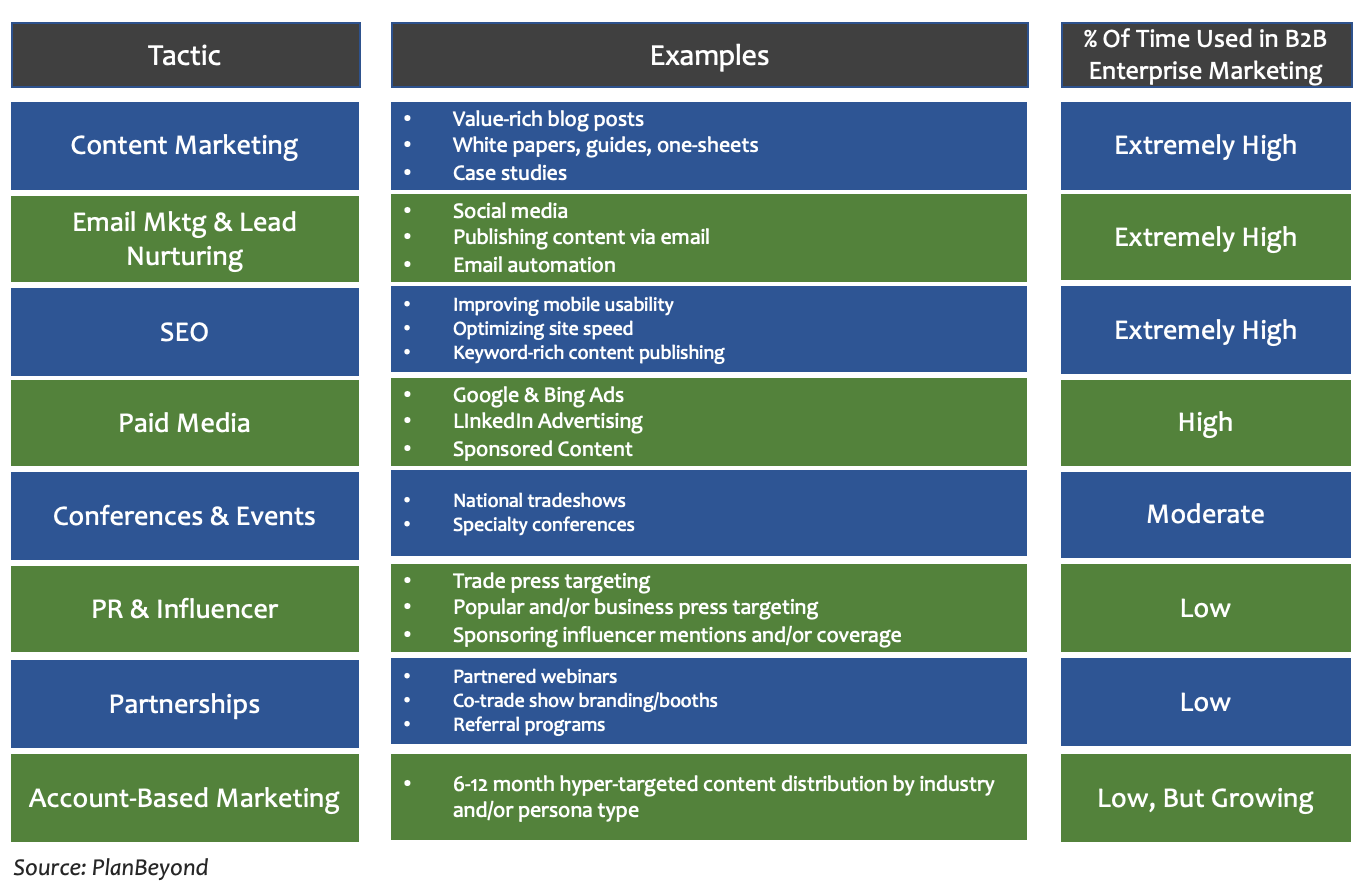Are you ready to hit the ground running and start acquiring leads and new customers? If so, you’re probably wondering what type of marketing you should do. While the marketing landscape can appear seemingly endless, you’ll generally find that B2B businesses leverage a select set of tactics. We’ll go throw the most commonly-found tactics in B2B marketing settings, what they typically entail, and when to consider leveraging them.
Of course, remember that solid marketing strategy should always precede jumping into the deep end and executing on tactics. If you haven’t thought this through yet, check out this post first on B2B marketing strategy.
B2B Marketing Tactics
The range of activities a B2B organization can leverage run the gamut from hyper-tactical advertising to more strategically-oriented content marketing. The diagram below offers a high-level primer of some of the most commonly used B2B marketing tactics. We’ll go through each one in further detail, but keep in mind one key thing: there is never one marketing silver bullet! Successful organizations employee several tactics (sometimes called channels) at the same time. It ensures reaching prospective customers at different points in their decision-making process as well as increasing the odds of being found at just the right time.

Content Marketing
What It Is: Content marketing is the creation of, well, content, for marketing purposes. This can take the form of blog posts, white papers, infographics, videos, podcasts or anything else that helps tell a story or share valuable information via written, visual or audio mediums. The key with content marketing is that it is valuable, “rich” content. That is, it helps educate a prospect and gives them information they otherwise didn’t have.
Use Frequency: Extremely High. The reason content marketing is so frequently used by B2B organizations is twofold. First off, it tends to be fairly cost effective, making it available to companies big and small. The second is that it can be used across the acquisition funnel. That is, content can be used to educate prospects that are just learning about a product or category, it can help them consider different solutions, and it can help them ultimately decide which product or service to buy. As a powerful tool for those with even the slimmest of budgets, content marketing is one of the most-used B2B marketing tactics around.
Email Marketing & Lead Nurturing
What It Is: Email marketing is using email to keep your brand, product or service top of mind. It can mean promoting your product directly or, more commonly in B2B, promoting the interesting, value-rich content you’ve created. It assumes that you are actively building up a database of individuals who have opted-in to receiving marketing communications (a.k.a leads), and therefore you can continue to nurture these individuals with timely marketing touch points until they’re ready to buy.
Use Frequency: Extremely High. Like content marketing, email marketing is extremely cost effective. For a monthly subscription to an email marketing service and the time spent setting up an email, you can reach prospects’ inboxes whenever you like. It’s a great way to reach people who have already shown interest in your business, and to do so frugally. Also, it’s a great way to get your content actually read.
SEO
What It Is: SEO stands for search engine optimization, which is another way of saying doing the work it takes to get found in a Google or Bing search. It’s a unique mix of web development work to get a website set up properly to make it easy to be found, as well as (usually) content marketing work to create information that individuals are actively searching for and increase the likelihood of someone landing on your website.
Use Frequency: Extremely High. Just about everyone does a web search to find a product that fits a need they have. This means companies want to be easily found when those web searches happen. Again, SEO does tend to skew on the more cost effective side of marketing tactics. It takes upfront web development work as well as ongoing content marketing work, but it all builds on itself. Continuous investments lead to long-term gains.
Paid Media
What It Is: Paid media can take the form of Google or Bing Ads, ads on social media sites like LinkedIn or Facebook, or promoting content on 3rd party sites. It often, though not always, is paid on a per-click basis, and can be a great way to get in front of prospects who may not know about you but have have a high chance of being interested in what you offer.
Use Frequency: High. For companies with products or services that are easily described in a few words, Paid Media can be a great marketing tactic. You can buy ads based to target individuals you know are actively looking for exactly what you offer, meaning you’re getting qualified leads.
However, there are two reasons it isn’t used more frequently. The first is cost. It may require a substantial budget to run ads effectively on search engines or social media platforms, or content placements on 3rd party sites may be cost prohibitive. The second is the (potential) inability to properly reach your audience. If you can’t easily describe your product or service in a few words, targeting people on Google or Bing may be challenging. Further, if your audience doesn’t regularly use social media platforms or read certain magazines or websites, it may mean spending money while not getting in front of the right audience.
Conferences & Events
What It Is: Using conferences or events as a marketing tactic generally means sponsoring the activity in some way. This often includes getting a booth space, getting your business’s name on event materials and sometimes, can include speaking opportunities. These can be effective ways to begin face-to-face conversations with prospects who you would otherwise never have a chance to connect with directly.
Use Frequency: Moderate. Attending, let alone sponsoring/speaking at an event, can be cost prohibitive. Additionally, if no events or conferences exist to target your core customer type, you certainly don’t want to spend money or time attending. Many organizations also fail to account for the necessary planning that must happen, which can include everything from reserving or purchasing both materials, coordinating colleague travel, schedules and accommodations and doing pre- and post- event marketing.
PR & INFLUENCER Marketing
What It Is: PR and influencer marketing essentially means leveraging other people’s existing reach to help build awareness for your product or service. It requires deliberately reaching out to a variety of outlets including trade, business press and (if applicable) consumer press to try and get picked up.
Use Frequency: Low. Doing PR effectively means having a focused PR strategy around developing pitches, developing pitch calendars and reaching out to journalists on a regular basis. Many organizations don’t feel comfortable doing this work in-house (buy they should!) and outsourcing it to a PR agency can be extremely expensive. Additionally, for B2B organizations whose products and services fall into very small niches, there simply may not be enough outlets or influencers covering their category to warrant deliberate PR efforts.
Partnerships
What It Is: Developing partnerships can entail a variety of arrangements, but at its core, it generally means working with at least one other organization that reaches your prospective audience to increase the chances of being found. This can be partnering with a trade association for a fee or possibly another company that has a non-competitive product but also reaches the same target customer. While the nature of partnerships can vary, at their core they’re about using other organizations’ existing customer or membership base to reach a qualified set of prospects.
Use Frequency: Low. Partnership are usually employed once other tactics are already in play. This is largely because the nature of the partnership itself can often be an unknown. This means thinking about opportunities, reaching out to potential partners and negotiating terms. It’s a lot of work for an unknown payout, making partnerships a lesser-used tactic.
Account Based Marketing
What It Is: Account Based Marketing (ABM) entails creating very personalized content and sending it to hyper-focused prospective customers. It can often take months to develop content, and then you’ll need to send that content via email and traditional mail to educate prospects about your expertise and thought leadership. ABM is less about closing customers and more about building awareness and interest in your product or service.
Use Frequency: Extremely Low. Several things must be true before embarking on ABM. An organization must have an extremely targeted customer prospect in mind (e.g. a particular job title at within a particular industry), be willing to accept at least six-to-twelve months worth of effort before seeing results, and have hyper-focused content to send to that target. These are very strict criteria that many organization can’t, or unwilling, to meet, making ABM a less-frequently used tactic.
Using B2B Marketing Tactics In Tandem
Like we said upfront, no single marketing tactic is going to win the day. The real secret sauce comes from using multiple marketing tactics at the same time. Fortunately, several tactics work well together, helping leverage efforts from one tactic to make the most out of another. For instance…
-
Content Marketing + Email Marketing: There is only so much people want to hear about your product. Developing rich content and sharing it via email is a great way to stay top of mind and showcase your category knowledge leadership…without bombarding prospects with product information they don’t necessarily want.
-
Content Marketing + ABM: Reaching out to targeted prospects requires having a good excuse to do so. Developing thoughtful content is a great excuse. It lets you offer something of value to prospects to help build awareness and interest in what you do.
-
Content Marketing + SEO + Paid Media: Developing great content and publishing it online increases the chances of getting found via Google or Bing searches, making it great for SEO. At the same time, you can offer up you content via paid media ads or placements, using your content as a way to collect contact information in exchange for valuable materials.
-
Conferences/Events + PR: If you know you’ll be investing in sponsoring upcoming conferences and events, time your PR outreach efforts just before those activities happen. It can help build some initial product or service awareness, just in time for meeting prospects face-to-face.
We could keep going but the message is the same: use a variety of B2B marketing tactics to make the most of your efforts and increase your chances of customer acquisition.





